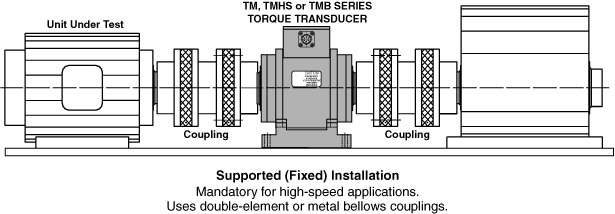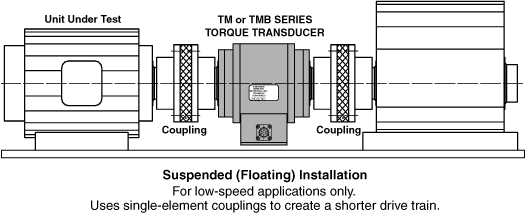Below is a list of frequently asked questions regarding the operation of our torque transducers. Should you need further assistance, contact Magtrol or your local sales agent.
Q: What is the largest torque sensor Magtrol can supply?
Due to our extended competencies in torque sensor design, Magtrol can supply a torque sensor having a rating of up to 150,000 N·m (1327613 lb·ft)! For ratings higher than 150,000 N·m contact Magtrol.
Q: Do you have a brake or actuator which is usable as a load for the TMHS series transducer?
With maximum speeds up to 70,000 rpm, the high-speed version (-HS) of Magtrol’s Eddy-current Dynamometers are well suited for this purpose. View speed and torque ratings here to select a WB Dynamometer for your torque loading needs.
Q: How do I select the right couplings, especially for high-speed applications?
The higher the speed of the application, the more care is required in selecting the coupling(s). Quality, high-speed couplings are very expensive—beware of “sticker shock”! However, this is not one place to cut costs since a substandard coupling can effect the entire drive train configuration (see next question). Every element of the drive train assembly must be meticulously aligned and balanced and the couplings are a fundamental component.
To complement your torque transducer or dynamometer, Magtrol can provide you with a dedicated coupling for your application. Simply contact Magtrol with your application details, maximum torque, maximum speed and shaft dimensions of the motor (drive) and load.
Q: I have noticed that my torque transducer sometimes starts and stops in the middle of a test. Then, after several cycles, the coupling slips off the torque axis. I can re-tighten it but the coupling still ends up damaging the axis. What is causing this?
In this situation, it sounds like a (cheap) poor quality coupling is being used. In such case, the solution is to use a keyed shaft.
Q: What is the difference in coupling selection between TM floating (suspended) mounting and TM fixed (supported) mounting?
For high-speed applications, fixed/supporting mounting is mandatory! In all supported installations, double-element or metal bellows couplings are recommended.
For safety reasons, suspended mounting should only be used for low-speed applications. Single-element couplings (selected in relation to torque, speed and transducer weight) are then employed to create a shorter drive train. Bellows couplings and double-element couplings are not suited for suspended (floating) installations.


Q: What is the best way to precisely align the shafts of the TM transducer with the shafts of the units to be tested (especially at speeds > 15,000 rpm)?
Laser aligning systems are the best method. If one is not available, use a dial gauge. If your system has a precision XYZ stage, run your system “no load” and adjust each axis until you reach the highest speed in the display. The system is best aligned at the highest speed.
Q: How should the coupling(s) be centered on the FTM Flanges—an option for transducers with splined shaft ends?
The transducers have cylindrical centering seats on each side of the splined shaft. Use only the centering seats for centering, not the splined part. When a TMHS (high-speed) Transducer is ordered with flanges, Magtrol will balance the flanges on the shaft and note the angular position (of the flange to the shaft).
Q: Can the TM be mounted in a vertical installation?
Vertical mounting is not a problem provided there is no weight suspended from, or supported by, the torque transducer. The transducer itself should be supported—the foot mount is recommended—otherwise, the total weight of the TM body will be hanging on its bearings. When assembling, take special care to avoid any stress on the bearings and make sure the couplings are free of any axial load prior to tightening.
Q: What is the total bandwidth of the complete measuring shaft line (TM + couplings)?
The measuring bandwidth is determined by the filter cutoff of the low pass filter (1 Hz to 5 kHz). In addition to this electronic filtering, there is a mechanical filtering of the driving line (motor shaft, coupling(s), torque transducer and load shaft). This mechanical bandwidth can be lower than the low pass filter setting.
Q: What happens if there is vibration in a suspended installation?
If a suspended (floating) TM transducer is submitted to vibration >> STOP!! Check the mounting, coupling, alignment and balancing. If you can not get rid of the vibration, change the installation.
Q: What is the maximum admissible vibration level (mm/s RMS) of each torque transducer?
Magtrol’s TM Transducers have been tested on a shaker table with a vibration level of 5 g’s. (1 g = 9806 mm/s²)
Q: Can I get a speed signal from the TM series Torque Transducer with out using a 3410 or 6400 Torque Display?
The speed signal on the TM Torque Transducer is an open collector configuration. You may need a pull-up resistor. Refer to the manual.
Q: Can I calibrate the TM series or TF series Torque Transducers myself?
No, it must be returned to Magtrol.
Q:What is the certification level of the Magtrol Torque Calibration Laboratory?
- All instruments in use at Magtrol are periodically checked by a certified laboratory (linked to National Standards).
- Weights used on the calibration benches are certified by Metas (Swiss National Certification Lab).
- Metas or DKD calibration certificates are available at an additional charge.
Q: I am searching for information on my Vibro-Meter Torque Sensor. This Product range has been taken over by Magtrol SA, but I am unable to find the information I am looking for. Do you still sell this equipment?
Magtrol continuously develops new products in order to meet our customers’ growing testing requirements. The older model you are searching for was probably replaced by a newer model (see the table below) which offers more features and employs the latest technologies. If you need further information on older/obsolete equipment, you can search our archived product manuals or contact your Magtrol sales representative.
| Vibro-Meter Torque Transducer | Magtrol Replacement Model |
|---|---|
| TG-0.2/BP TG-0.5/BP TG-1/BP | TM 301 to TM 307 |
| TG-2/BP TG-5/BP TG-10/BP | TM 308 to TM 311 |
| TG-20/BP TG-50/BP | TM 312 and TM 313 |
| TG-100/BP | TM 314 |
| TG-200/BP | TM 315 |
| TG-500B/P | TM 316 |
| TG-1000/BP | TM 317 |
| TG-2000/BP | TF 218 |
| TG-3000/BP TG-5000/BP | TF 219 |
| TE 106/M3 | TM 308 or TM 309 |
| TE 107/M3 | TM 310 |
| TE 108/M3 | TM 311 |
| TE 109/M3 | TM 312 |
| TE 110/M3 | TM 313 |
| TE 111/M3 | TM 314 |










